









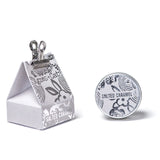
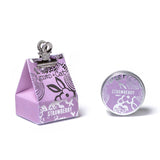
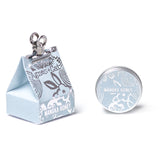
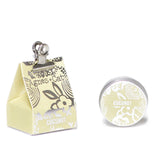
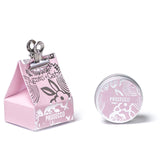
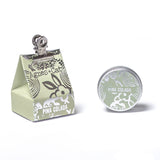
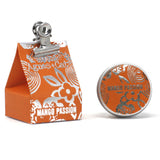
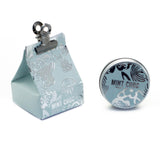
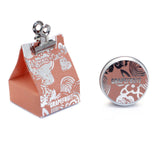
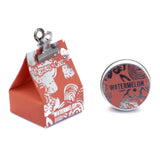
Luscious Lip Balm
Indulge your lips with our luscious and natural Lip Balm collection, featuring an array of irresistible flavors that will leave you feeling pampered and nourished. Our hand-poured lip balms are infused with shea, mango, and avocado butter, and enriched with jojoba oil to provide intense hydration and replenishment for your lips.
Our Coconut, Watermelon, Strawberry, Manuka Honey, Salted Caramel, Pina Colada, Mango Passion, Mint Chocolate, Grapefruit, and Prosecco variants are the perfect treat for your lips. They offer long-lasting hydration and protection, ensuring that your lips stay soft, smooth, and healthy throughout the day.
Our unique packaging is both stylish and functional, making it a great addition to your purse or makeup bag. And with our natural and nourishing ingredients, you can feel good about what you're putting on your lips.
Whether you're looking for the perfect stocking filler or gift for friends and family, or just want to indulge yourself, our Natural Lip Balm collection is the answer. Order now and give your lips the gift of beautiful, healthy, and deliciously scented lips.
Using lip balm is a simple and effective way to keep your lips moisturized and protected. Here are the general directions for using lip balm:
1. Start with Clean Lips:
- Ensure your lips are clean and free from any debris or old lip balm. You can gently wipe your lips with a damp cloth if needed.
2. Select Your Lip Balm:
- Choose a lip balm that suits your preferences and needs. Lip balms come in various formulations, including plain, flavored, medicated, tinted, and with different ingredients like beeswax, shea butter, or SPF.
3. Open the Lip Balm:
- Remove the cap or lid from the lip balm container. Some lip balms may come in stick form (similar to lipstick), while others may be in a small pot or tin.
4. Apply the Lip Balm:
- Gently glide or dab the lip balm onto your lips. You can apply a thin layer for a natural look or a thicker layer for added moisture and protection.
5. Use Your Finger (if necessary):
- If your lip balm comes in a pot or tin, you may need to use your clean fingertip to scoop a small amount and then apply it to your lips.
6. Cover the Entire Lip Area:
- Make sure to cover your entire lip area, including the upper and lower lips. Pay attention to the corners and edges as well.
7. Reapply as Needed:
- Depending on the lip balm and environmental conditions, you may need to reapply it throughout the day. This is especially important in dry or windy weather.
8. Avoid Overuse:
- While it's beneficial to use lip balm to prevent dryness, avoid excessive use as it can lead to dependency, where your lips may become reliant on the product. Apply it as needed to maintain lip health.
9. Sun Protection:
- If you're going outside, consider using a lip balm with SPF to protect your lips from the sun's harmful UV rays. Apply it before heading outdoors and reapply as necessary.
10. Store Properly: - Keep your lip balm in a cool, dry place and replace the cap or lid securely after each use to prevent it from drying out or becoming contaminated.
Using lip balm regularly can help keep your lips soft, hydrated, and protected from the elements. It's a simple and essential part of a daily skincare routine, especially during dry or cold weather.
Lip balm is a common and often essential item in many people's daily routines. Here are some fun and interesting facts about lip balm:
-
Ancient Origins: Lip balm-like products have been used for lip care and protection for thousands of years. Ancient Egyptians, for example, used a mixture of beeswax and olive oil to keep their lips moisturized.
-
First Commercial Lip Balm: The first commercial lip balm, known as "ChapStick," was invented by Charles Browne Fleet in the 1880s. It was initially sold in a small glass jar.
-
Lip Balm Stick: The familiar lip balm stick format was introduced by John Morton in 1912 when he created a moldable lip balm known as "Carmex."
-
Flavored Lip Balm: The first flavored lip balm, which was strawberry flavored, was introduced in the 1970s. This innovation made lip balm more enjoyable to use.
-
Variety of Flavors: Today, lip balm comes in a vast array of flavors, including fruit, candy, dessert, and even unconventional options like bacon and pickle.
-
SPF Protection: Many lip balms now include SPF (Sun Protection Factor) to protect the lips from the sun's harmful UV rays. It's a crucial element for lip health.
-
Addictive Ingredients: Some lip balms contain ingredients like menthol or camphor that create a tingling or cooling sensation. This can make users feel addicted to the product.
-
Lip Balm Art: Some creative individuals have used colored and flavored lip balms to create lip art, turning their lips into miniature canvases for artistic expression.
-
DIY Lip Balm: Making your own lip balm at home has become a popular DIY project. You can customize the ingredients and flavors to your liking.
-
Multifunctional Lip Balms: Some lip balms are formulated for multiple uses, such as moisturizing dry skin patches, cuticle care, and even soothing insect bites.
-
Collectible Items: Limited-edition and novelty lip balm containers have become collectible items for enthusiasts. Some people have extensive collections of unique lip balm designs.
-
Lip Balm for Chapped Noses: Lip balm is sometimes used to soothe and moisturize chapped noses during cold and flu seasons when tissues can cause irritation.
-
Wax-Based: Most lip balms are wax-based, with common ingredients like beeswax, shea butter, cocoa butter, and various oils to provide moisture and protection.
-
International Popularity: Lip balm is a global product, and each culture may have its own favorite brands and flavors. For example, in Japan, "Lip Cream" is a popular term for lip balm.
-
Emergency Fire Starter: In a pinch, some lip balms can be used as a fire starter due to their wax content. It's a handy survival trick.
Lip balm has a rich history and has evolved from a basic protective product to a diverse and enjoyable skincare item with various flavors and benefits. It's a small but significant part of many people's daily routines.
